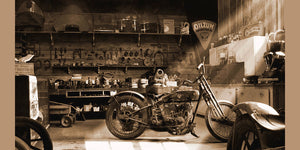Your Go-To Motorbike Shop for Top Quality Parts and Accessories
Your Go-To Motorbike Shop for Top Quality Parts and Accessories
Blog Article
Recognizing the Essential Parts of a Bike: A Comprehensive Overview for Lovers
For motorbike enthusiasts wanting to raise their riding experience and ensure their bikes run smoothly, understanding the vital components of a bike is critical. Each element, from the engine's complex operations to the vital duty of the braking systems, not just influences performance however additionally safety and comfort. This overview will certainly go through the essential parts that every rider ought to recognize with, allowing informed choices in both maintenance and prospective upgrades. As we begin this expedition, one must ask: exactly how does each element communicate to create the smooth ride every enthusiast looks for?
Engine Parts

The camshaft plays an important function in regulating the timing of the engine's valves, guaranteeing the exact opening and closing essential for reliable fuel and air intake, as well as exhaust expulsion. This timing is vital to keeping optimal engine performance and effectiveness. Additionally, the carburetor or fuel shot system, depending upon the motorbike version, is in charge of blending air with fuel in the appropriate ratio for burning.
The air conditioning system, either air or liquid-based, works to keep the engine's temperature within operational restrictions, preventing overheating and ensuring durability - motocross parts nz. Each element, diligently designed and integrated, adds to the smooth operation of the engine, defining the bike's power output and total efficiency
Transmission System
Essential to the motorcycle's capability, the transmission system ensures effective power transfer from the engine to the wheels. This system comprises a number of crucial parts, including the clutch, transmission, and final drive, each playing an important function in translating the engine's power into activity. The clutch, typically run by a hand bar, serves to disengage the engine and involve from the transmission, permitting for smooth equipment modifications and regulated velocity.
The gearbox, usually referred to as the transmission correct, consists of a set of gears that riders can by hand shift through to change the bike's rate and torque output. These equipments are arranged in a series that makes it possible for the motorcycle to increase smoothly and keep optimal engine efficiency across various rates. Many bikes use a sequential gearbox, requiring the rider to move equipments in a fixed order.
Braking Mechanisms
While comprehending the transmission system is crucial to taking advantage of a motorcycle's power, similarly crucial is the capability to control and quit that power efficiently, which is where stopping systems enter play. Brakes are crucial for security and efficiency, providing the motorcyclist with the required control to navigate numerous surfaces and problems. Usually, bikes include 2 types of stopping systems: disc brakes and drum brakes.
Disc brakes are more prevalent in modern-day motorbikes due to their remarkable efficiency. They are composed of a brake disc, caliper, and pads. When turned on, the caliper presses the brake pads against the rotating disc, transforming kinetic power right into heat, thus slowing down the wheel. This system supplies far better heat dissipation, regular performance, and improved stopping power, especially in damp conditions.
On the other hand, drum brakes, though less usual, are still located in some motorbikes. They work by pressing brake footwear versus the internal surface of a drum connected to the wheel. While generally much less effective in warmth dissipation and stopping power, drum brakes are simpler and extra cost-effective.
Understanding these stopping systems' nuances enables bikers to preserve their a knockout post motorcycles effectively and appreciate the design that ensures safe and reliable stopping.
Suspension and Steering
Suspension and steering systems are crucial parts that dramatically influence a motorcycle's handling and adventure comfort. The shock absorber, including forks at the front and shock absorbers at the back, takes in road irregularities, enhancing security and control. Front forks, normally telescopic or upside down, compress and rebound to alleviate effects, while back shock absorbers keep tire contact with the roadway, essential for grip and safety and security.
Steering, centered around the handlebars, links the biker to the motorbike's directional control. The steering head bearings guarantee smooth operation, allowing exact maneuverability. Appropriate alignment and maintenance of these bearings are important for predictable guiding action and reducing cyclist exhaustion.
The suspension's adjustability is another important aspect; preload, damping, and rebound settings permit modification to fit various riding designs and conditions. This versatility is vital for maximizing performance, whether browsing city roads or tackling rugged tracks. Technologies like electronic suspension systems supply real-time adjustments, improving ride high quality throughout diverse surfaces.

Electric Equipments
After guaranteeing a controlled and smooth trip with reliable suspension and guiding systems, interest turns to the electrical systems, a critical aspect of contemporary motorcycles. These systems play a crucial role not just in beginning the engine yet additionally in powering various parts that improve the capability and safety and security of the bike.
At the heart of a bike's electric system is the battery, which shops electric energy necessary for starting the engine and powering auxiliary systems - moto parts nz. The alternator or generator, combined with the rectifier-regulator, makes sure the battery continues to be charged while the motorcycle functions, converting power into electrical energy and preserving voltage degrees
The ignition system, an additional essential part, is liable for sparking the air-fuel blend in the engine's cyndrical tubes. Modern motorbikes usually utilize a digital ignition system, offering greater advice performance and reliability compared to typical systems.
Illumination systems, consisting of headlights, tail lights, and signs, are also essential, ensuring presence and safety and security for the motorcyclist. Added electronic parts such as sensors, control units, and displays add to advanced features like gas shot monitoring, anti-lock braking systems (ABDOMINAL), and electronic dashboards, even more improving the riding experience.
Final Thought
A detailed comprehension of a motorbike's like it vital components, consisting of the engine, transmission system, stopping mechanisms, suspension, steering, and electrical systems, is crucial for fanatics aiming to maximize safety, convenience, and performance. Proficiency of these aspects enables informed choices relating to upkeep and upgrades, ultimately improving the riding experience. By incorporating this knowledge, cyclists can ensure their motorcycles run at peak efficiency and reliability, thereby maximizing both satisfaction and durability of their lorries.
For motorcycle enthusiasts looking to elevate their riding experience and guarantee their bikes run efficiently, comprehending the important components of a bike is paramount.Indispensable to the motorcycle's functionality, the transmission system makes certain effective power transfer from the engine to the wheels.While understanding the transmission system is key to using a motorcycle's power, similarly vital is the capability to manage and stop that power effectively, which is where braking devices come into play. Normally, bikes feature 2 types of braking systems: disc brakes and drum brakes.
A detailed comprehension of a motorbike's necessary components, consisting of the engine, transmission system, stopping devices, suspension, steering, and electrical systems, is crucial for lovers aiming to maximize convenience, performance, and safety.
Report this page